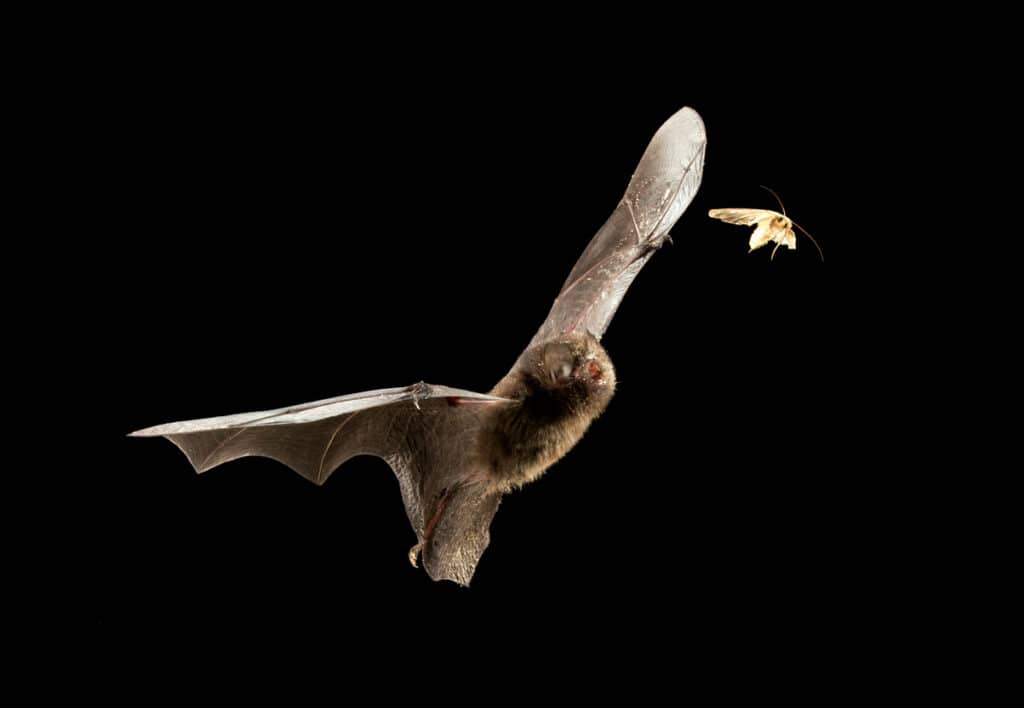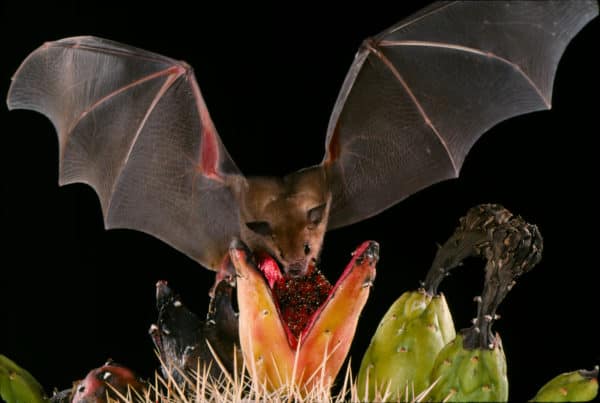Bats are the primary controllers of vast numbers of night-flying insects. Single colonies can consume tons of crop pests nightly, and they pollinate and carry seeds for many of our planet’s most important plants. Read on to see just some of the ways that bats help make the world a nicer place to live!

Pest control
- Insect-eating bats save farmers approximately $23 billion in annual agricultural losses in the United States alone.
- Millions of free-tailed bats from Bracken Cave, Texas eat more than 100 tons of insects nightly, intercepting billions of migrant pests before they can lay eggs, a huge savings to farmers.
- Just one bat can catch 1,000 mosquitoes in a single hour, helping reduce the spread of diseases such as West Nile virus.
- A colony of just 150 big brown bats can eat enough cucumber beetles in a single summer to prevent them from laying 33 million eggs that hatch into rootworms, a devastating crop pest.
- In Europe’s Iberian Peninsula, small, strategically placed bat houses, by attracting just 5 pipistrelle bats per acre, were able to eliminate pesticide spraying in rice paddies.
- Bat pest control in Indonesia saves cocoa growers approximately $780 million annually.
- Bats are primary predators of green stink bugs, the most serious pests of macadamia nut orchards.
Seed Dispersal and Fertilizer
- Bats are primary reforesters of tropical clearings, sometimes dropping more than 95% of first “pioneer plant” seeds required to begin regrowth.
- Bats are the primary seed dispersers of Central America’s Sapodilla tree, the original source of chewing gum, Chiclets. This tree is also prized for its fruit and timber.
- Fruit-eating bats appear to be the best long-distance dispersers of the Neem tree, one of the world’s most medicinally important species.
- Bat guano provides essential energy for countless cave microorganisms, many of which are of potentially great value for improving detergents, medicines, and waste detoxification.
- Bats from Khao Chong Phran Cave in Thailand provide annual fertilizer sales of $132,000, rice crop protection valued at $300,000 and aid businesses by attracting thousands of tourists.
- Bats disperse seeds for mangoes, peaches, and guavas – among many more fruits!
Pollination
- From deserts of the American Southwest to the high Andes of South America and the Caribbean Islands, hundreds of species of agave and cactus plants rely on bats for pollination.
- All commercial bananas originated from bat-pollinated ancestors in SE Asia. Commercial bananas in the U.S. don’t have seeds, so they don’t need to be pollinated, but the wild bat-pollinated bananas remain key sources of genes for improving disease resistance and new varieties.
- Mexico’s entire tequila industry relies on a single species of bat-pollinated agave plant.
- The famous night-blooming baobab tree of East African savannahs relies on bats for pollination, provides key wildlife habitat and is one of the world’s richest sources of vitamins, with sales amounting to roughly a billion dollars annually.
- SE Asia’s favorite fruit, the durian, sells for more than a billion dollars annually and requires bat pollinators even when grown in orchards.
- Bat-pollinated mangrove trees of SE Asia provide vital flood and erosion control, timber, charcoal, breeding grounds for fisheries and key habitat for a wide variety of wildlife.
- Approximately 70 percent of all tropical fruits eaten by humans rely on bats as primary pollinators or seed dispersers in the wild, ranging from bananas and mangoes to peaches, cashews and dates.
Safeguarding Human Health and Prosperity
- Despite scary speculation from those who profit from human fear, bats have an extraordinary record of living safely with humans, many times better than our own beloved dogs.
- Bats safeguard our health by reducing dependence on dangerous pesticides and by consuming disease carrying pests, including the mosquitoes that carry West Nile virus.
- Since even sick bats rarely bite unless handled, for anyone who simply leaves them alone, the odds of harm are extremely remote.
- Research on bats has contributed greatly to the advancement of medical technology and to improved navigational aids for the blind.
- Without large populations of bats to keep insects in check, pollinate flowers and carry seeds whole ecosystems upon which we ourselves depend could be seriously threatened.
- The 1.5 million bats living in Austin, Texas have proven to be safe and invaluable neighbors, consuming tons of insect pests, attracting millions of tourist dollars and harming no one.
A lesser long-nosed bat (Leptonycteris yerbabuenae) feeding on the fruit of saguaro cactus (Carnegiea gigantea) in Mexico. Visit the photo gallery for more bat photos!

